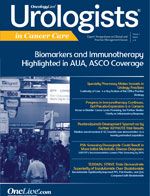Grasp of Clinical Science Now a Necessity in Urologic Oncology
The world of precision medicine is upon us and we as providers, especially those involved in the management of oncology patients, will need to be conversant and have an understanding of these various pathways and drivers in order to more effectively manage our patients
Raoul S. Concepcion, MD
PARP, CTLA-4, PD-L1, VEGF, HER2/Neu, PI3K/AKT/mTOR, PIP, Hsp90A, BRAF, cMET, SPARC, PTEN, CAR-T, AR-V7, NK92: the lexicon in the world of genomics, proteomics, and targeted therapies continues to expand and permeate into the urology literature. However, no longer is it unique to those doing basic science research. It will soon become part of our clinical vocabulary as well. The world of precision medicine is upon us and we as providers, especially those involved in the management of oncology patients, will need to be conversant and have an understanding of these various pathways and drivers in order to more effectively manage our patients.
For those who attended the annual meeting of the American Urological Association (AUA) and possibly the American Society of Clinical Oncology (ASCO) two weeks later, the number of abstracts and presentations that focused on the use of “—omic” pathways, whether it be diagnostic, therapeutic, or prognostic, was astounding. For prostate cancer, the opportunities and challenges are seemingly endless: Whom to biopsy? Whom to treat or not treat? Whom to rebiopsy? Who will best respond to secondary hormonal manipulation versus cytotoxic therapy versus immune therapy, and when to change therapy? What are the resistance mechanisms? Are they primary or acquired?
There are many open questions in the area of urothelial cancers. Which patients with nonmuscle invasive bladder cancer (NMIBC) will progress to muscle invasive (MIBC) disease? Who are the patients with NMIBC that may not need cystoscopy every three months and would it be blasphemy to suggest it in a urology publication? Are there signatures in MIBC patients that will respond to neoadjuvant chemotherapy versus those who should forego chemotherapy up front? What is the significance of the early promising results of the anti-PD1/PD-L1 therapies in MIBC? Will they play a role in combination with bacillus Calmette-Guérin (BCG) in NMIBC?
As we have discussed many times in this publication, the role of the urologist in the management of our cancer patients is rapidly evolving. We can no longer just be proceduralists or diagnosticians. We will need to think more like clinical scientists. However, the basic approach will fundamentally be the same. From a surgical standpoint, for the most part, the best outcomes are a result of knowing the indications for a particular procedure and applying it to the correct patient clinical scenario. Hopefully, one would offer urethrectomy at the time of radical cystectomy for patients with MIBC that have prostatic urethra or bladder neck involvement. The same intellectual processing needs to take place as we move into the molecular space with the use of —omic data to determine appropriate therapeutics.
The challenge of sequencing and combining drugs is far from clear, and this will only become compounded as companies and the FDA want to fast-track more and more targeted therapies with no biomolecular markers to guide us and only the clinical patient presentation and organ of origin. Are we making progress? Absolutely. But there is still much to be learned and discovered: circulating tumor cells (CTCs), cell free DNA, micro RNA, etc. These represent another set of abbreviations and verbiage that 10 years ago we as surgeons would have never dreamed that we would need to know in order to optimize patient care. These assays are very much still in their infancy and, as we are all aware, none of them are entirely reproducible or reliable, nor commercially available (let alone reimbursable). However, it is estimated that the number of cancer survivors in the United States requiring care by the year 2020 will be 18.1 million patients at an estimated annual cost of $173 billion. The biggest drivers of this increase, relative to 2010, will be prostate and breast cancer, up 42% and 32%, respectively.1 The cost of each therapy approaches $100,000. It is an unsustainable spiraling cost that the system cannot tolerate.
As payment reform continues and we, as a specialty, want to be the flag bearer for urologic malignancies, it is imperative that we make every attempt to evolve from the classically trained urologic surgeon to the urologic scientist. Yes, next generation sequencing (NGS) often provides us with more questions than answers. Many of the epitopes identified do not have approved targeted drugs. But in order for us to remain relevant in the world of urologic oncology, we must continue to keep pace with all these scientific breakthroughs, not only to offer optimal patient care but also to be fiscally prudent in our therapeutic decisions.
Mariotto AB, Yabroff KR, Shao Y, et al. J Natl Cancer Inst. 2011;103:117-128.




